Return to Theme Table of Content
Return to VJIC Table of Content
Mike Amrose is a photographer and filmmaker living and working in Buffalo, New York (USA). He earned a MA in filmmaking from the Center for Media Studies, University of Buffalo.
Visual language of Photography — a visual form of communication using visual elements and principles to construct a photographic language through which photographers convey meaning, emotions, ideas, opinions, and narratives.
1900-1975
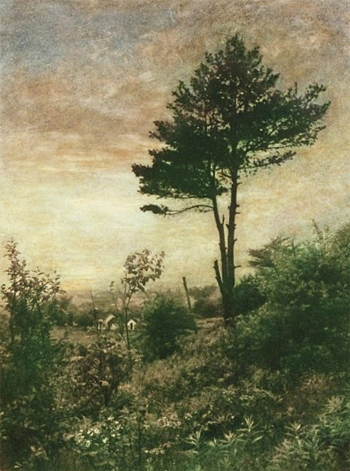
John L. Garretson (1885-1948), Pine Crest, undated; Burchfield-Penny Collection
In the 19th century, photography was used primarily for portraits, landscapes, architecture, and science. Photojournalists documented Native Americans, settlers, and life in the West as well as the Crimean and Civil Wars. Photographs captured reality in a way far superior to painting, and in turn, sights previously unseen captivated viewers. The art world, however, saw photography as a mechanical replication of reality with no feeling or vision. Photographers were not considered artists, nor was photography considered an art form.
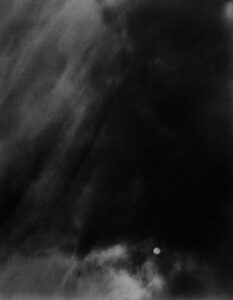
Alfred Stieglitz, Equivalent, 1925, source: Wikepedia
Nevertheless, at the beginning of the 20th century, Modern photography, departing from the language and constraints of traditional forms of art, began with innovative applications of form. A new visual language of fine art photography evolved with the experimentation, creativity, and vision of many photographers including its biggest supporter, Alfred Steiglitz, who was considered by many the “father of modern photography.” In 1902, he founded the Photo-Session, a group that seceded from traditional art rejecting what he believed was its outmoded beliefs and ideas. In the following years, he launched Camera Work, a journal promoting photography as a new form of expression—fine art. Additionally, in 1905, with the help of Edward Steichen, he opened gallery 291. The gallery promoted photography as a fine art through exhibitions by Paul Strand, Edward Steichen and European modernist painters and sculptors.
Steiglitz embraced and championed what he called “straight photography”—high contrast photographs with sharp focus, crisp detail, high contrast, and rich tonalities revealing the underlying geometric structure of the subject. Straight photography moved towards modernism and away from pictorialism. Pictorialism was a late 19th century form of image production that attempted to imitate painting. It was used to justify photography as an art form.
“Pictorialism is an international style and aesthetic movement that dominated photography during the later 19th and early 20th centuries. There is no standard definition of the term, but in general it refers to a style in which the photographer has somehow manipulated what would otherwise be a straightforward photograph as a means of “creating” an image rather than simply recording it. Typically, a pictorial photograph appears to lack a sharp focus (some more so than others), is printed in one or more colors other than black-and-white (ranging from warm brown to deep blue) and may have visible brush strokes or other manipulation of the surface. For the pictorialist, a photograph, like a painting, drawing or engraving, was a way of projecting an emotional intent into the viewer’s realm of imagination.” (Wikipedia, 26 November 2020) It is important to note that Steiglitz was a pictorialist before moving to what he referred to as “straight photography”. (The reader is directed to “The Photo-Pictoialist of Buffalo” by Anthony Bannon, 1981 for a richer example.)
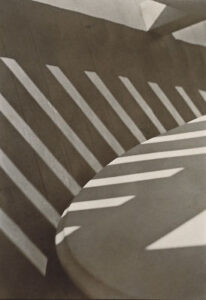
Paul-Strand-Porch-Shadows-1946. Source: The-Art-Story.jpg
Both Strand’s and Steiglitz’s goal was to present the scene as realistically and objectively as possible without manipulation while expressing meaning beyond the reality portrayed in the photograph. Photography was a new way to express one’s self by creating an image, an abstraction, with a subjective vision conveying emotions, interpretations, meanings, or ideas. Their application of this new expression produced photographs where subject matter was free from a literal interpretation. Stieglitz produced abstract photographs of clouds titled Equivalents and Strand created abstract photographs of shadows.
Hungarian Laszlo Moholy-Nagy was an influential teacher at the Bauhaus, an avant-garde art school in Germany. He believed that the camera could see the world in a new way different from that of the human eye.

László-Moholy-Nagy-Z-VII-1926-nga-1. Source: Wikepedia.jpg
With his wife, Lucy, Moholy-Nagy aimed to create a universal photographic visual language of the modern era termed “New Vision” which they considered impersonal, mechanical, and therefore, objective. Images of modern life — skyscrapers, towers, and machines — were photographed using extreme angles, close-ups, and other shooting and darkroom techniques to affect one’s perspective of the subject. . In his application of these processes and techniques, he created new abstract images expressing a new visual language.
As time progressed, photographers continued to explore and experiment with the medium. Artists continue to discover new ways to create new realities — new visual languages. One such way was cameraless photography. Two of the most noted cameraless photographers were Moholy-Nagy for photograms and Man Ray for rayograms. Cameraless photography, still in the realm of Modernism, created strange abstractions using recognizable objects and unknown forms. It demonstrated Moholy-Nagy and Man Ray’s continued desire to create a new form of art and a new way to see the world.
“A true photograph need not be explained,
nor can it be contained in words” —Ansel Adams.
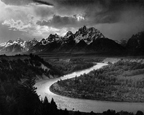
Ansel Adams, The-Tetons and the Snake River. 1942,Wikipedia
Ansel Adams is recognized for his breathtaking black and white images that reveal a sense of the mystique of nature’s magnificence. He was a pioneer of photography. Following the tenets of straight photography, his iconic images of the American west were noted for their detail, balance, deep depth of field, black sky, and particularly, their broad range of tones from deep blacks to bright whites.
The darkroom became as relevant as the capture of the image in presenting his unique visual language. The zone system he developed gave photographers, even today, the ability to create continuous gray tones from deep black to bright white in most lighting situations. The system revolutionized black and white photography.
In the 1930s and 1940s, documentary and photojournalism became prevalent. Like Ansel Adams, other photographers were also part of the “straight” photography movement. In the 1930s, The Farm Security Administration (FSA) sent photographers throughout the United States to document and justify the need for New Deal projects as the country was in a great depression. Iconic photographs expressing the pain, suffering, and plight of farmers and migrants were created by documentary photographers such as Walker Evans and Dorthea Lang. Wars of the period saw a proliferation of photographs by photojournalists like Robert Capa and Joe Rosenthal.
Photography in the first half of the century was within the context of Modernist theory with many photographers expressing ideas, meanings, and feelings in a unique visual languages. Modernism was popular until the 1970s.
1945- Present
Postmodern photography is characterized by atypical compositions of subjects that are unconventional or sometimes completely absent, making sympathy with the subject difficult or impossible. Like other postmodern artists, the champions of postmodern photography contend that it is possible to ignore the “rules” and still create art. —Postmodernist Art and Photography, 2014

Andreas Gursky Zoobrücke, Köln-1988.
The second half of the 20th Century saw the beginning of Postmodernism in Western society and culture. Postmodernism was a rejection of Modernism and its rigidity, and a reaction to the basic principles and practices of modernism. Postmodernists focused on popular and more democratic ideas of art. This led many artists to connect deeply to social issues. Artists were released from the form and structure of modernism allowing them to depart from traditional rules of art. It offered a wide latitude to go beyond Modernism theory to convey meaning about the world, society, and everyday life.
Modernist and Postmodernist Movements shaped the art of the 20th and 21st century while influencing photographers’ experimentation, creativity, vision, and art. Postmodernist Theory and its tenets along with technological advances have given photographers more tools, techniques, and processes to express themselves. Photographers have more capabilities and opportunities to innovate and create. As a result, visual language has become more comprehensive, expansive, and unrestrained leading to a proliferation of photographic genres like figurative art, abstract art, minimalism, op art, pop art, and storytelling, street photography, and conceptual art photography. With each genre and those not listed comes a multitude of visual languages.
Visual Language Today
The visual language of photography is comprised of visual elements and principles of art. Elements, each of which is normally independent of the image’s interpretation, are the building blocks of the image. The principles arrange the elements bringing them together into a cohesive, affecting design. The visual elements, each having a sensory response, are line, color, pattern, texture, space, shape, form, value, light, time, perspective, focus, and text. Principles include unity, harmony, balance, emphasis, proportion, contrast (value), and rhythm. Composition arranges the elements according to the principles and unifies the image to express the photographer’s statement of intent. Composition plays an important role by creating an aesthetically compelling and impactful photograph that communicates the photographer’s intent. (Note: Various publications and writers deviate from the number and type of elements and principles.)
Can a photographer create their own unique visual language?
The answer to this question is “yes.” Reviewing the history of photography, one can see many innovations and changes to the visual language over time from Modernist photographers Steiglitz and Moholy-Nagy to Postmodernists such as Andy Warhol and Cindy Sherman. The visual languages they and many others created are truly unique. Their photographs are recognized for their artistic value, delivery of their message, and the application of their visual language.
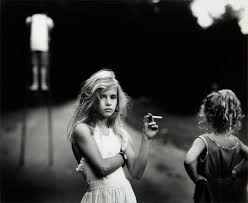
Sally Mann, Candy Cigarette, 1989 © Sally-Mann
What makes a visual language unique? Let us assume there is a fine art exhibit showing photographs of a particular type for example still life or architecture, and each image effectively communicates a message or an emotion. Some of the images will be similar to other images conveying similar messages while other images will stand out. Why? Their visual language and the messages they communicate are different and distinctive. They used the visual language in a way that drew in and spoke to the viewer and communicated a message or an emotion. As a result, one can probably say that their visual language is unique. What about the visual language of similar photographs?
If the photographs are similar, one can assume the visual language used by them is also similar. The language may even be unique, but it does not communicate or connect with the viewer. Communication is considered essential. There may be some variations that attract one’s attention, but not enough to overcome any deficiencies. It may be the situation where if you’ve seen one, you’ve seen them all. Looking to the past at “straight photography” adhered to by Steiglitz, Moholy-Nagy, Westin, and Ansel Adams, the basic vocabulary of the language was established. Yet, the visual language each used would not be considered the same. The visual language they used effectively communicated messages or emotions specific to their vision. Moholy-Nagy used unconventional viewpoints and printing techniques to portray the modern world, whereas Ansel Adams created black and white images with black skies and an incredible range of tones from a point of view and perspective expressing the magnificence of nature and our relevance to it. These photographers give credence to the fact that one can take a visual language, creatively apply visual elements, and effectively create a unique visual language.
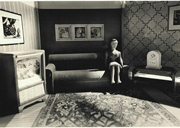
Laurie-Simmons. Woman Listening to the Radio, 1978, source: Art Space.
A photographer’s visual language may be a derivative of others with visual elements used differently. The visual language created may be considered new and as such, unique. Even if the viewer does not perceive the photographer’s intent, and instead, creates a narrative or finds emotion in the image, the visual language speaks to the viewer. The visual language works though not according to its strict definition. Today, there are thousands and thousands of photographers most of whom we have never heard of and will never hear of creating their own unique visual language.
Creating Your Own Unique Visual Language
Writers Note: When writing this article I wrote on creating a fine art photograph having a unique visual language?” I proceeded to write the steps a photographer could take to accomplish this. However, having done it myself, I decided to write about my experience in the development of my photographic language rather than going step by step through the process of simulating a textbook. Besides, most photographers have done this.
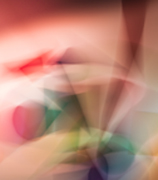
Michael Amrose.2020, Corona-Dreams
I was involved in photography years ago. After a few years I attended film school where I studied documentary film. Then life got involved and I did very little in photography or film. Finally, in 2008 I purchased my first digital camera. For about two years I had little direction shooting nature, people, buildings, found objects, textured objects, and on and on. I experimented with natural light, shadows, movement, macro images, filters, lenses, etc. I realized that with the digital camera one can take many pictures at no cost, unlike film. I had the opportunity to experiment not only while shooting but also in postproduction (Also free except for software). As I shot more photographs, I was becoming very interested in abstract photography and my ability to express myself through it.
In my bedroom, I was attracted by the early evening sun, shining through the curtains. I photographed the curtains experimenting with their movement, the movement of the camera, zooming in and out, and so forth. In postproduction, I was able to create images that were unique and emotional. I experimented with colored acetate on the window to add more color and created very different images. However, after a couple of years, I realized that I was limited in terms of color, shapes, textures, and lighting. I had to find a subject in which I could create images with the same emotive qualities. I also needed more control, more capabilities, and fewer limitations.
In my search for a new subject, I tried two and three-dimensional collages, cardboard with shapes cutout, tar repair on asphalt (summer months only), and much more. There were many successes but there were problems of consistency, messaging, and access. Some I just didn’t like. Though I stopped trying for quite a few months, I didn’t stop thinking of ideas. Finally, I had my aha moment! I would create shapes, colors, lines, and textures using a variety of media such as colored acetate, paint, fabric, or paper that I could then manipulate in-camera to produce the type of images I sought. For seven months I experimented with shapes, colors, lines, textures, lighting, lenses, camera movement, exposure times, double and triple exposure, and my patience and my commitment. I sought control of the visual elements, images that emote, and the ability to duplicate similar images.
After seven months, hundreds of hours, and 14,000 photographs, I created a several unique visual languages. Many were not an exact fit from what I visualized though they were good; others, not so good. My process was very similar to the section I wrote previously but omitted from this article. With a vision to communicate (my goal), I used visualization, planning, experimentation, and implementation to create my unique photographs with unique visual languages.
Return to Theme Table of Content
Return to VJIC Table of Content
Vi
